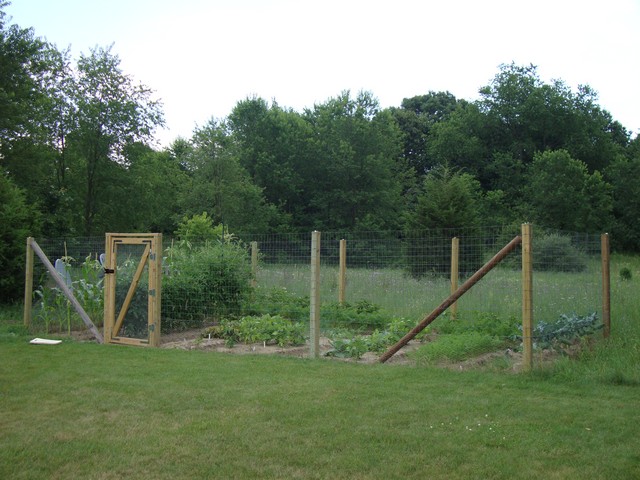
When we decided to put in a vegetable garden, we realized a proper fence with a good gate was essential. As you can see, our property is surrounded by a lot of woods, and we have wild life to show for it. Approximately 90% of all the trees we have planted, whether apple trees, dogwood, flowering pear, or maple trees have been destroyed by deer and rabbits, despite much effort to prevent it. Naturally, we figured: if these animals love trees, they will surely love our vegetables! So a fence was never a question, it was a necessity. In this post, using lots of pictures to explain, I will describe how my husband built our fence; I assisted a little here and there, but he did all the planning and building. He didn’t have any pre-made plans to help him, he just thought about what might make sense and went from there.
Several years later, it is still going strong and in very good shape. And to think, all I wanted was some wire to go around and some way of getting in and out of my garden, and this is what he built me! According to himself, my husband is a technical kinda guy, not a handy-man. And while he is excellent at anything technical, I beg to differ. Just look at that nice work! More beautiful than I ever hoped for, and highly functional! Thank you, sweetheart!!!
Since my fence went up, I’ve grown all kind of vegetables and the experience has been very interesting and fun! Along the way I’ve written some tutorials; a lot of people have found the tomato series and potato series especially helpful as they show step by step in pictures and words just what to do when planting from seed and beyond.
Building the Fence
To build the fence around my vegetable garden, my husband started out putting in 8-foot posts, 4×4 inches or so around. He put one in each corner first, and I believe he tied some string between the posts to place the other ones in straight lines. Two of the posts were placed close together to serve as gate posts. He placed them a distance apart that would allow me to wheel my wheelbarrow through it after the gate was put in.
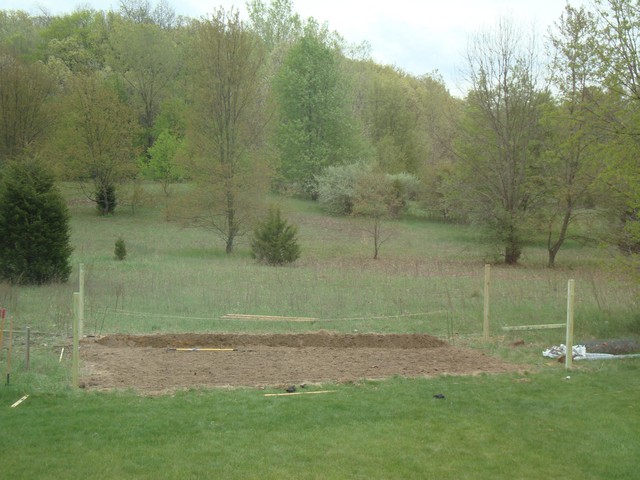
He first dug holes with a regular shovel, then used this nifty post hole digger tool to help him get deeper down without much effort. He put the poles 2 1/2 feet down into the ground. Some people use cement. We didn’t, and it has still held up very well.
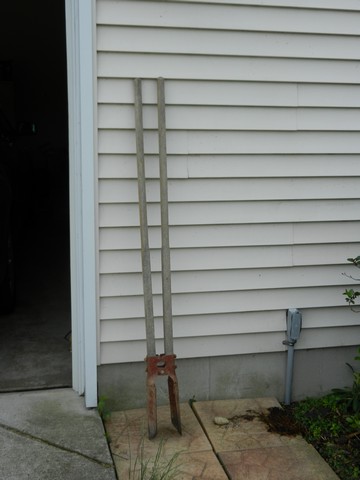
You push this tool down into the dirt, and when you pull the handle apart, it closes around the dirt and you just need to lift it up, out of the hole. Then you repeat until the hole is as deep as you want it.
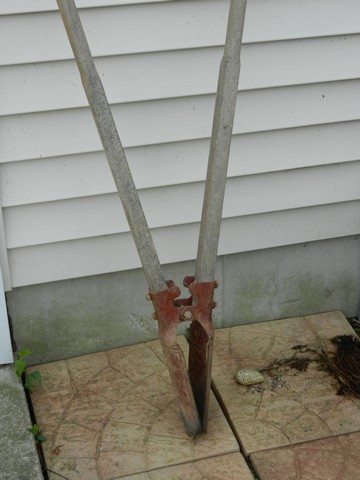
He put in the posts, filled with dirt, packed it down as much as he could by stomping it down and using a shovel to press into it to pack it as much as possible. Then he waited a day or so for the dirt to settle, though more time might have helped it settle more. We didn’t have much time as the season was well under way and I needed to get things planted. So the next day, we put the fencing wire up.
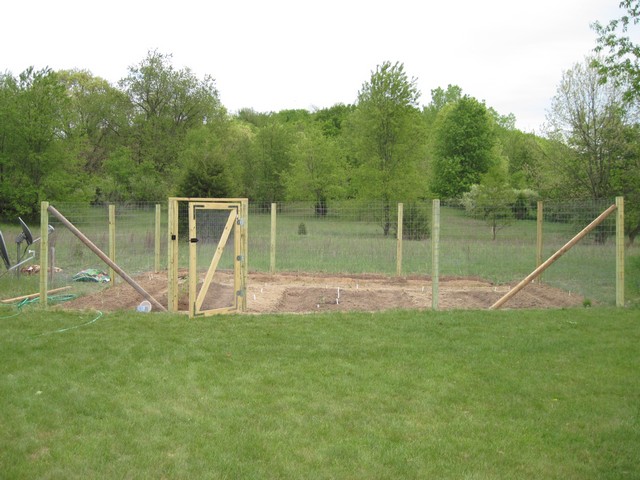
Below is a picture of the fencing wire we put up as the main part of the fence. This wire fencing, as seen in this link, is 4 feet tall, though we added chicken wire as well, with a total fencing height of 5 feet 5 inches. Later on we added electric fencing in addition. (Looking at the link, unless they’ve edited it by now, you’ll see that Home Depot gave an incorrect height measurements, as you can also see in a comment from one of their customers. It is 4 feet tall, not 39 inches.)
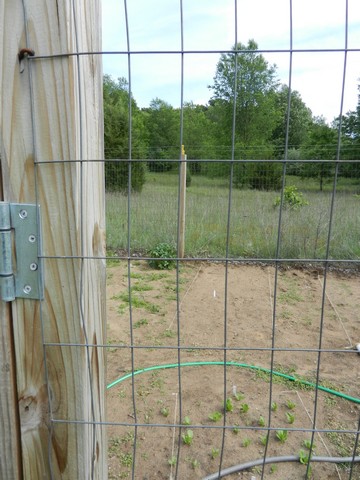
I thought he really found a good way to fasten it, with as little effort as possible. He nailed in some short nails with large, flat heads, but didn’t hammer them all the way in. This allowed him to hook the fencing onto the nails, which held it in place until it was wrapped around the whole area, then he hammered them in a bit more to hold the fencing in place. Both of us pulled the fencing to the next post, hooked it onto the nail in that post, then stretched it to the next post, and so we went until we got it all the way around.
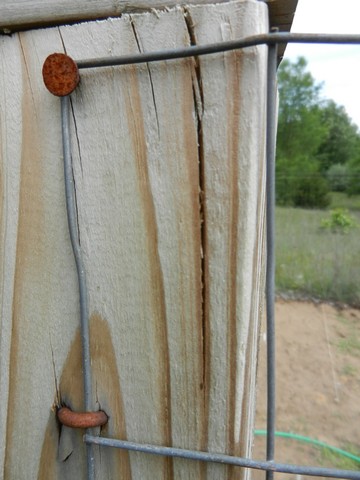
Further down on each post, as seen at the bottom left of the picture above, he nailed in galvanized fence staples, sort of like double nails or V-shaped, that can be hammered in to hold something in place:
So the advantage is that you can hold wiring in place, like in these pictures. He also used more of the large-flat-head nails to fasten, hammering the heads onto the wire to hold it in place. In the following pictures you only see the ends of the V-shaped staples.
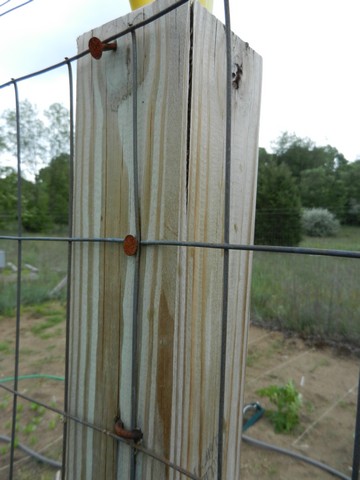
He used these same materials on the corner posts. The yellow thingy you see on the top of the post in the following picture is for electric fencing, which we ended up having to add later on, due to raccoons getting into our corn. I will briefly describe that below.
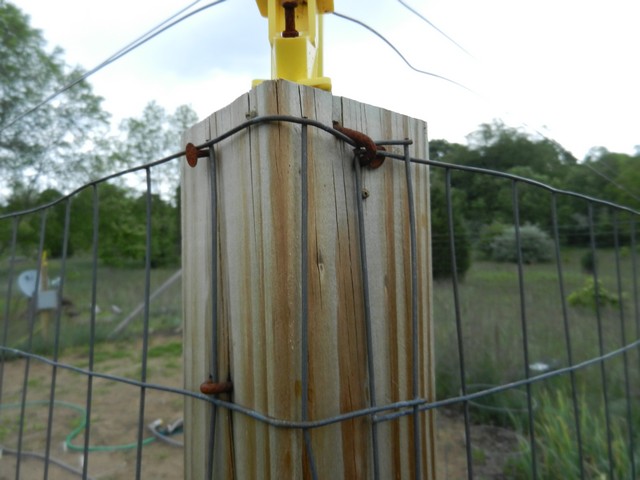
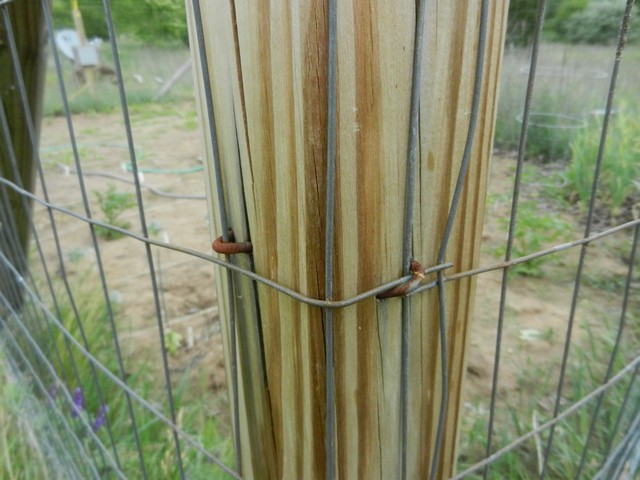
The fencing material we used was for the most part the type you see in the pictures above, though we also decided to add chicken wire, also called chicken netting, on the bottom two feet or so to prevent smaller critters from getting into the garden. There would be far to many temptations and munchies in there to keep all the rabbits out, so chicken wire was also necessary. Since bunnies can, and often will dig underneath fences, we put approximately 17 inches of this netting on the bottom of the fence, so from the ground up to meet the other fencing. Then we wrapped the rest of it out onto the lawn, like a curtain that hangs on the floor and draped out to rest on the floor. So half went out onto the lawn, and half went up to form the bottom of the fence. This way, the bunnies would meet more fencing if they tried to dig, and so far they have not been smart enough to go further out onto the lawn to dig themselves through. I didn’t take pictures of it back then, as I hadn’t started my blog yet and didn’t realize I might someday want to show pictures of it to someone! At this point it is buried under the grass that grew through it and can’t even be seen anymore.
We fastened the chicken netting to the fencing above it with the wire that came with the chicken netting when we purchased it. The netting came in a roll, and was held together with some type of steel wire. So we just took it off when we unrolled it and clipped it into pieces of a few inches long to fasten the fencing materials together.
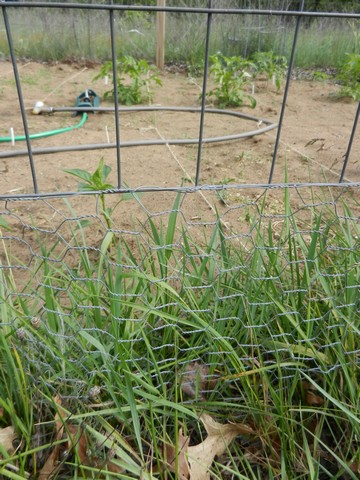
The next picture is taken from the inside of the garden; we may have weeds in our garden, but not a lawn! We fastened the wire around the fencing like this: (We just wound it around here and there.)
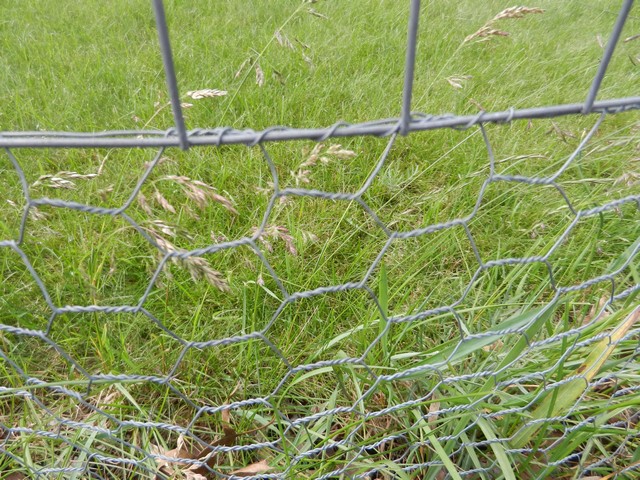
We fasten it in areas of about 8 inches or so apart, about like this for my hands:
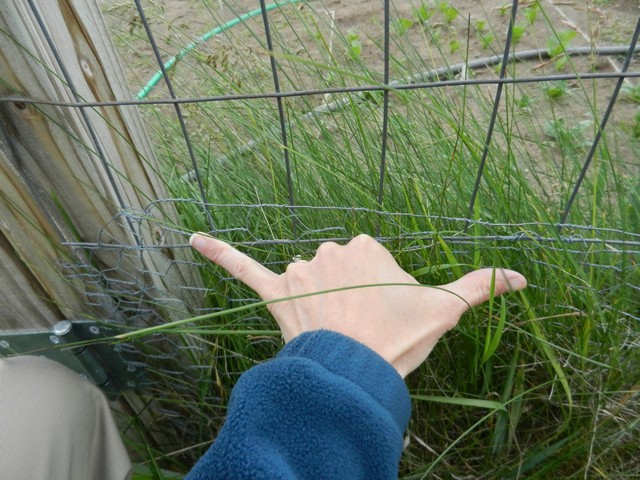
And on the posts, we used these staples, and more galvanized fence staples and nails here and there.
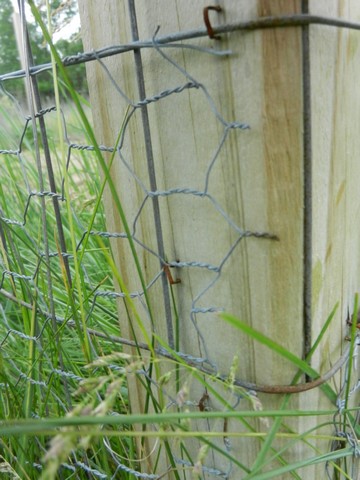
Then my husband made the beautiful, very useful gate. This too, he just put it together based on the size he wanted, and measured and cut the boards accordingly, to fit together. There is a board on the very top and bottom, that helps stabilize and hold it all together. Tall people do have to stoop to get through, but it makes for a solid gate. I am short enough to be able to walk right through it, so it suits me perfectly. The boards we used were a 4×4 post on either side, then 2×4 boards for the rest. The gate ended up being a little bit too narrow to fit properly between the posts, so he put in another 2×4 alongside the 4×4, to make that part a little wider. You can see it on the left side of the gate.
The height of the opening, and the posts on either side of the gate, is 5 ft. 6 in., with the door itself slightly shorter to fit between the top and bottom boards. The opening is slightly wider than one yard.

These angled brackets were purchased at Home Depot, along with other materials as well. They were fastened onto each corner, on both sides of the door.
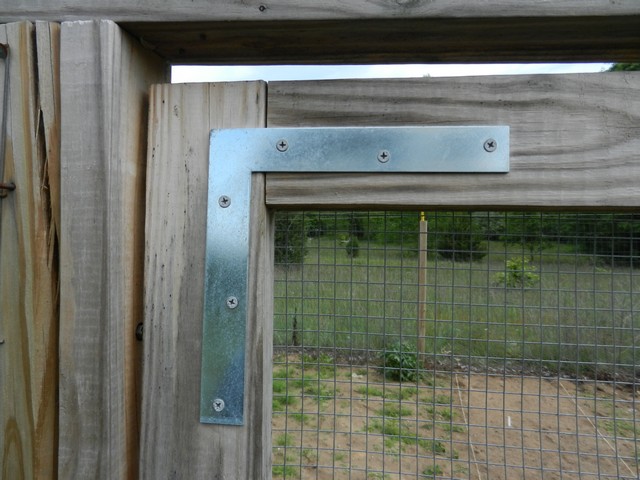
These hinges are approximately 4 1/4 inches tall, to give you an idea of the size.
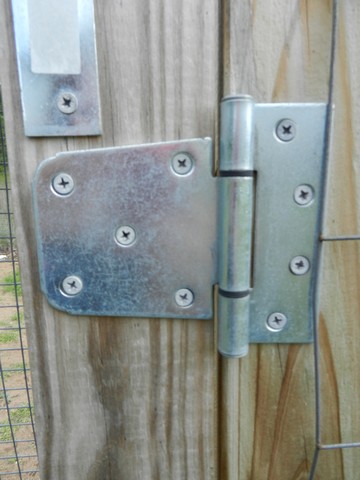
Another board was put into the door diagonally, to stabilize it, and prevent accidents that might push in the netting. Long screws were put in to fasten this board.
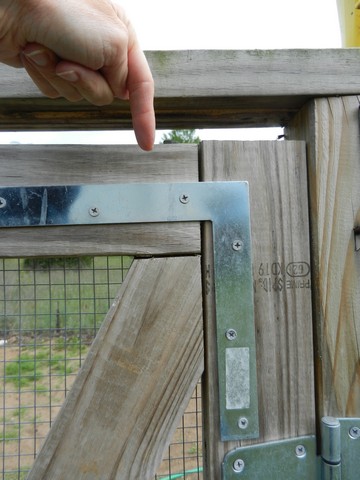
This is the screw.
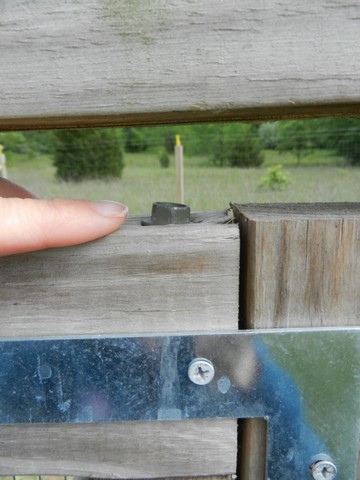
This is a very nice gate latch, it works well to keep the gate closed and is easy to open as well.
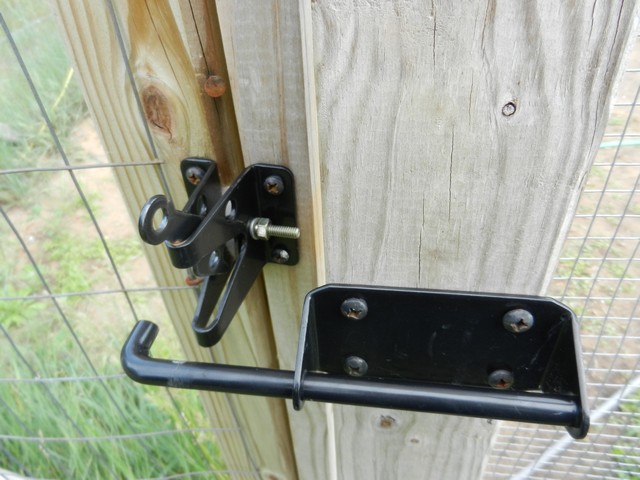
The only thing about it is that the screw that went through the little “latch-thingy” when you open it, fell out or rusted, or somehow broke off. So my husband put in a different screw instead, so it now works like a charm again. I tend to think we have to go buy a new one when something breaks, but he always seems to find a way to fix things. I am so blessed to have him! This one from Amazon seems to be the same kind we have, although there are several other ones to choose from as well.
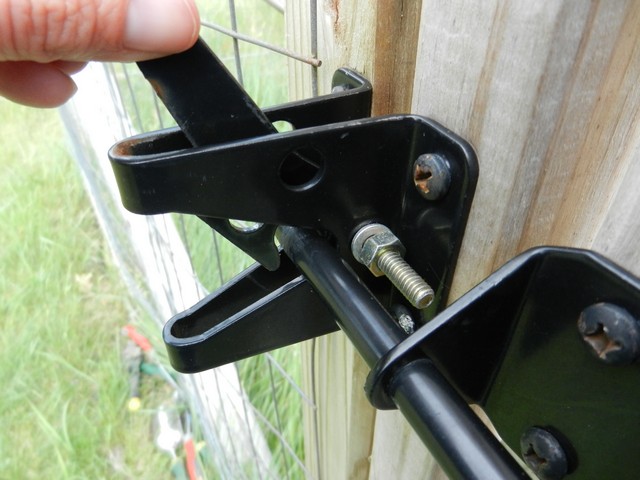
Fortunately, my hands are small enough to fit through the fencing, which is a good thing since it happens frequently that the wind causes the gate to close on me while I’m inside the garden! I’m not going to want to attempt to climb this fence, so I’m glad I’m able to sneak my hand through the fence to open it again, from the inside. See, it happened again just as I was inside today to take some pictures for you! Although one of my readers commented below that the hole in the latch release is designed to let you fasten a cord to it, then with a weight fastened to the cord, you can throw it over to the other side of the gate to give you a way to open it from the inside. Just pull the cord and it opens. Haha, I do have a few things yet to learn! I love it when my readers share helpful information like that!
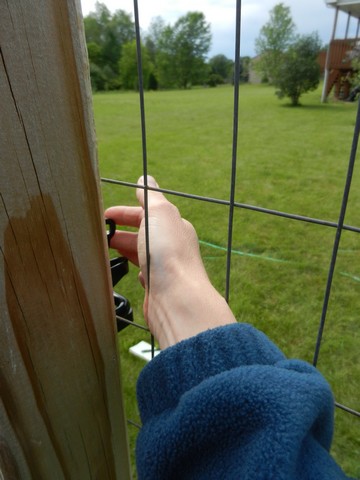
Then we put up a different type of wire, or netting, onto the gate. This netting is quite stiff and strong. Here’s a comparison of the size of the holes to my hand:
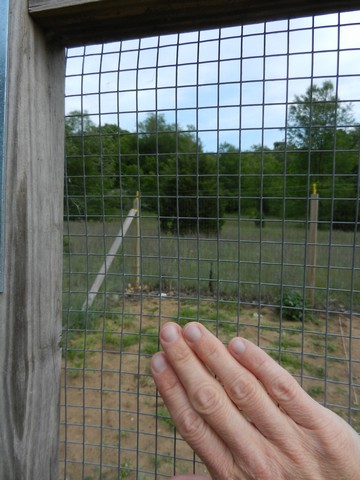
My husband fastened this netting to the inside, using the same method as above:
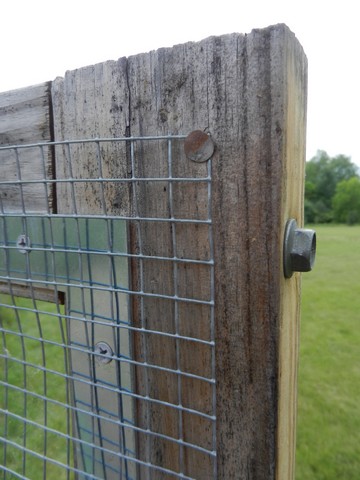
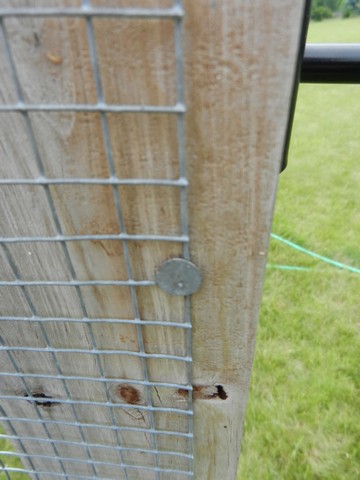
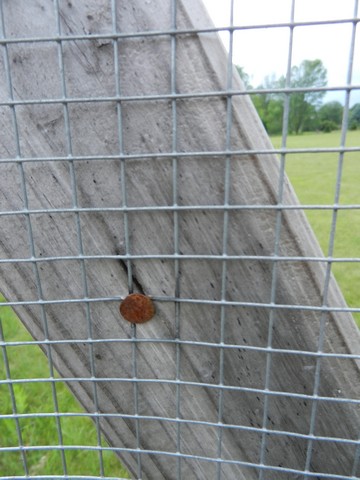
After it all had been put together and the posts began to settle more, we saw that the posts started leaning toward each other. We figured they leaned because of the tightness of the fencing, so my husband ended up putting in more posts, this time forcing them between the poles diagonally to push and keep them apart and standing straight. This might not have happened had we had the time to wait for a week or so to allow the poles to settle, or if we had put them into concrete. It really is hard to say if more time for settling would have made a difference, but these angled posts fixed the problem.
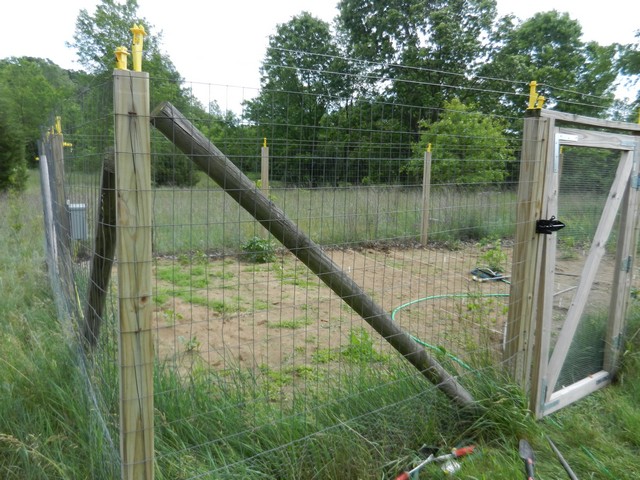
Like I mentioned, we ended up having to put up electric fencing on top of the fence, to keep out raccoons. Before this el. fence was put up, they came into my garden and destroyed most of my corn crop, despite attempts such as spraying with strong pepper solutions, to keep them out. After the electric fence was put up, we never had any more trouble with them.
These yellow brackets are insulators that does the job of holding the wire, as well as serves as insulators to keep the electricity where it’s supposed to be. Having it fastened directly to the wood would have shorted it, plus maybe giving people a little surprise now and again. These insulators were found in the same area of the store as where the wire was located. My husband decided to use aluminum wire rather than steel, as aluminum is light weight and easier to work with, and won’t rust. One wire might do the trick, but two works better as it’s harder for critters to climb over them.
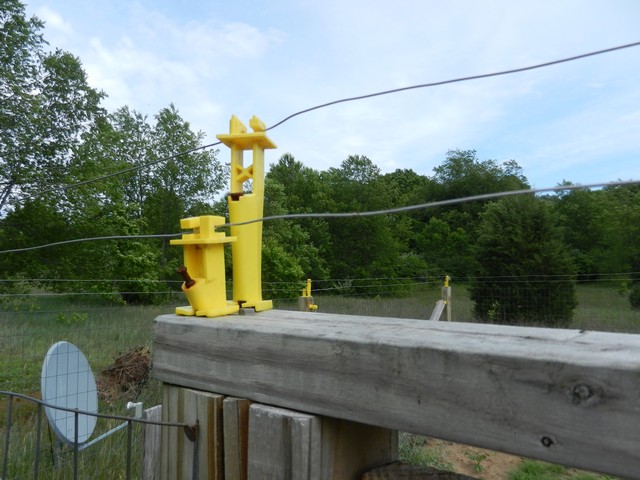
A utility box might not be necessary, but my husband wanted to put one up to protect the electric fencing controller.
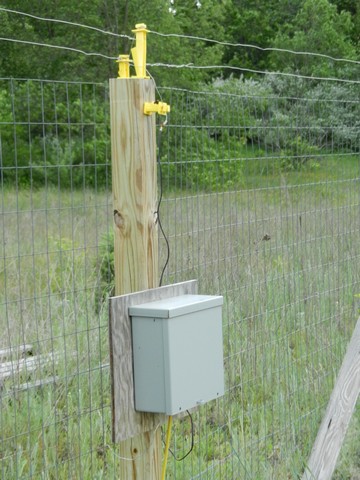
This is the finished fence before the electric part was added:
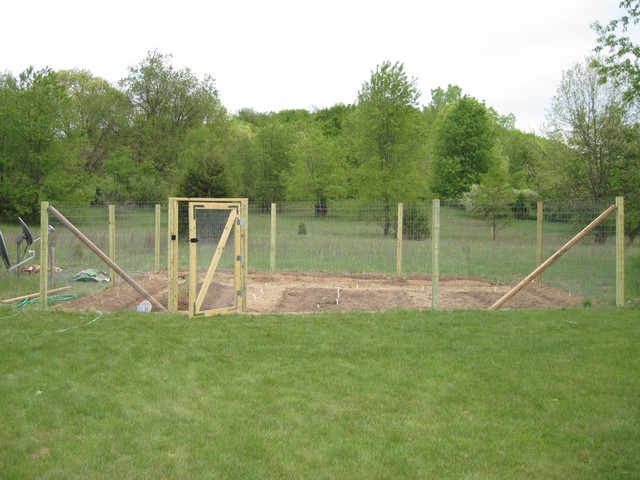
This vegetable garden fence has been so useful for us throughout the years, and to think my husband build it by himself quite easily, without any kind of purchased how-to guide! I hope this information and the pictures are helpful to the rest of you so you can figure out how to make a fence and gate that will work for your needs. I just love having the opportunity to plant and grow wonderful, healthful food right in my own yard! I hope you’ll enjoy your garden as well!


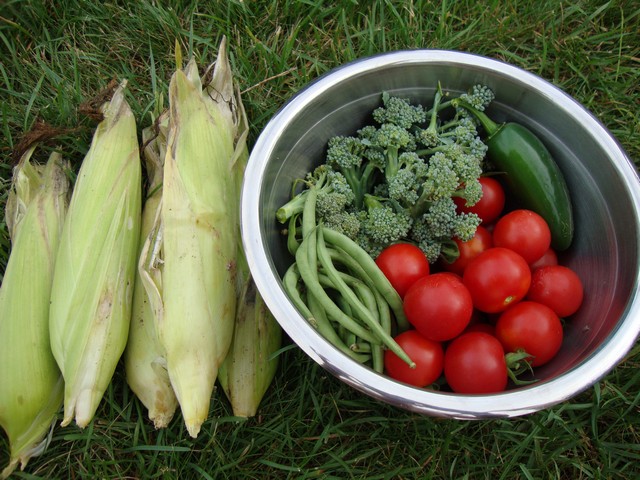
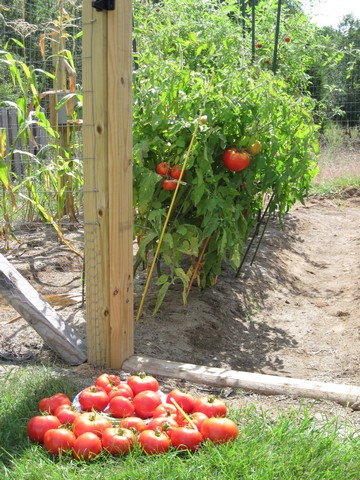

Thanks for posting this. It will definitely help us when we are ready to put in our new garden!
Glad to hear it! 🙂
What great pictures! Quite critter proof, indeed! 🙂
Yup, critter proof is what we need out here. 😉 Thanks for your comments, that’s always appreciated and fun!
I love the pictures! Thank for sharing. Btw, where do you guys live? Do you know in what countries, people usually use garden fence?
Thank you! We live in the midwest area of USA. We definitely need a fence here, due to rabbits and deer mostly, as we are close to wooded areas. People in city areas may only need a short fence to keep rabbits out, although some will not put up a fence at all and will just deal with the loss, if any. I don’t know what the situation is for people in other countries, I suppose it depends on wild life. In some parts of Norway, where I come from, fences are not necessarily needed at all. Some find out by experience, like we did when we had corn. We found that raccoons still got in, so needed electric fencing on top to stop them. Now that we don’t have corn, we don’t need the el. fence at all anymore.
Thank you so much ^^
Excellent post and pictures thank you so much for sharing…. Much appreciated 🙂
Great post and well- documented with the photos. The lock on your gate has a hole on the top of the latch release. It is designed to hold a cord with some type of weight to throw over the top of the gate to let you unlatch it from inside. Might save you some skinned knuckles!
Thanks for the tip, I never even considered that! Will have to take your advice and get a weight on it. Thanks for letting me know!!! 😀
Yup, put a screw eye in the top of the post and thread your latch string through that on its way up and over, like that it stays where it is supposed to. Easy peasy.
Thank you Martin!
I’m wondering how the fence held up over the winter. I know from having lived in both Minnesota and Missouri that there’s a wide range of coldness in the great Midwest. How for north are you? Do you think 2 1/2 feet is adequate? (I’m now in the snow belt on the south shore of Lake Ontario.)
Hi there! Well, our fence has held up really well so far. It has gone through 3 winters, and no problems. I am in zone 5, and south of you, so though we do have snowy, cold winters, but not as bad as some places in the US or Canada. Since we are not professionals, I don’t really know how deep or how tall you should go; I can only tell you what we did. And it has worked well for us. Our fence seems to be here to stay. But there may be other requirements for areas with colder climates. Maybe someone at a garden center will know?
This is fantastic! Thanks so much. I love the step by step with pictures.
Very helpful guide. The chicken wire at the bottom to keep out the smaller critters was brilliant.
That looks great! I just built a similar thing but for a chicken coop. I just used chain link fence in Toronto for the outside and well it basically looks like your contraption.
Interesting! While out driving, I also saw someone else who had built one so similar to mine that you’d think we knew each other! It is also fun to see how different people come up with different solutions.
Thanks for sharing. Is there a battery in the electric box for the electric wires or have you run an electric cord from house? Looks like a yellow extension cord out the bottom of electric box.
No battery, there’s electricity that we ran from the house, like you said. It’s not up and running these days anymore, now that we don’t have corn (so the raccoons have left the rest alone.) But yeah, we were able to plug it in right by our back door, so that was very handy and made things easy.
Terese,
I love your post. The pictures are great too. Thank you for sharing them. My question is this: would you happen to know the length & width of the entire garden fence structure? And did y’all have to use more than a single roll of the wire fencing?
Thank you!!
I couldn’t find the measurements, so my son helped me take new ones this morning. It is not entirely rectangular, but close. One of the shorter sides is longer than the other, so that makes no sides the same. The two long sides are 29 ft. versus 28 ft. 10 inches, and the two short sides are 19 ft. 5 in. versus 12 ft. So the perimeter is 29 ft. x 12. ft x 28 ft. 10 in. x 19 ft. 5 in. Size wise I feel I have just enough to be able to experiment with new plants and have plenty of room for what I want to grow. There is room for a lot, and I know I could have grown it all in a smaller space as well. But we have plenty of room, so we could afford taking this space. Sometimes it feels like more than I want to deal with, so I may have gone just a little bit smaller if I were to redo it. Then again, plenty of people have much more than I do.
As far as rolls of fencing, I can’t remember how many rolls we may have used, but hopefully the measurements for perimeter will help in figuring that out depending on the roll you’re looking at and how many linear feet comes on it. I hope that helps! I just double checked the measurements, looks like I got it pretty close.
Great fence & gate. We too are adding fence to an existing garden, but her in our area of MT, we don’t worry too much about raccoons, the coyotes will get them. Deer is our worst worry, with skunk also a potential problem. Your husband’s design has given me inspiration on how I will proceed. As for cementing the posts, our fence place here says they will rot sooner, even if pressure treated, some lasting as little as 5-7 years, with dug-in posts still great after 10-12 years. We recently recycled some posts taken down at a local wild bird nesting area. These posts were in the ground for probably 20 years, and most still looked great, showing just a small amount of “thinning” where they were below ground. The exposed parts showed more wear, but for our purposes (not using for fencing) they are great and the price was right!
That’s very interesting to know! I suppose we can be happy we did as we did, then! Thank you for sharing this with the rest of us!
Great post and thank you for the pics as well. I am interested in knowing the length and width of the entire garden. Are you able to provide that information? It would very helpful for us. Ty
Thank you! The size of the garden is as follows: The two long sides are 29 ft. versus 28 ft. 10 inches, and the two short sides are 19 ft. 5 in. versus 12 ft. So the perimeter is 29 ft. x 12. ft x 28 ft. 10 in. x 19 ft. 5 in. This information plus a bit more detail on the size was added to reply to a comment from July 18, so take a peak at that as well. 😉
Love the step by step. I am in Florida and raccoons are a problem when i use fish fertilizer. Will raccoons climb a 3 foot chicken wire fence? I was thinking that 3 feet was plenty tall to keep them out, but if they are climbers this won’t work.
Thanks for your input.
The Pepperman
If they want in, they will climb without a problem. It’s amazing what they will do. They had no problem getting over our fence until we put on electric wiring. That did keep them out for us.
Do critters ever try to get under the gate?
Good question, but no, there is a wooden post on the bottom of it, attached to the frame. This helps keep them out and also keeps the gate stable. They could try to dig underneath that post, but we haven’t seen any evidence of any digging.
How far apart did you put your fence posts?
Probably 6-8 feet? I will have to get back with you on it later when I can measure.
This is a very helpful article, Terese. Thanks for sharing your experience and insights. I’m going to build a fence similar to yours. But instead of using electric wire to keep the racoons out, I’m going to try using longer fence posts and putting loose chicken wire around the top 18-24 inches. I’ve read that the wire flopping down when they climb up will keep them out. We’ll see!
Thank you, I’m glad you found the information helpful! And hopefully the chicken wire will do the trick. I have found, for my garden, that the only vegetable raccoons have been interested in, is corn. So now that we don’t grow corn anymore, they have not been back, even with the electricity off. Depending on your area, you may not even need anything at all on top.
I love this writing! I am finally retired and living my dreams, as you described in your intro above. I have 4 raised beds and a couple of weeks ago I had my first deer visit!!!! I don’t want that to happen again. Your picture looks exactly life what I am planning. Thanks for the tips. I will look at more of your writings too. What state are you in. I’m in East Texas. Thanks!
Oh deer! I hope they didn’t destroy too much, but sounds like they did enough since you definitely don’t want them back. As beautiful as they are, they sure can leave their mark! I hope you’ll be able to keep them out with your new fence. Personally I’m in the Midwest. Thank you for your comment, I’m glad you found this blog post helpful!
I love that you use the wire mesh combined with the chicken wire to completely contain the garden. The chicken wire ensures that nothing can get underneath, while the wire mesh is strong enough to keep larger things out. I will definitely have to try building something like this around my garden to protect it. Thanks!
Thank you! I’m glad you found it helpful! A lot of years later my garden remains protected, so it has been very helpful for us. Have fun with your garden!
hi,
Very nice write up. Helpful and inspiring . Thanks. I want to know if the mesh is going to rust . Also did you put anything underneath so that the small animals won’t dig through . ?
Regards,
Geeta
Thank you! The mesh should not rust much, at least not for a while. There is just a little bit here and there on mine, and my fence is now 7-8 years old. The bottom chicken wire is wrapped onto the lawn a bit, and we have never had critters dig into the garden as far as I know.
Nice job. I have squirrel issues and adding the electric fence like you did. Did you run the ground wire into the ground or did you connect it to the main fence?
Thank you! I will check with my husband what he did, I’ll get back to you in a little bit. 😉
I talked to my husband about it, and he explained that he connected the main fence to the ground via a ground stake that we pounded into the ground. I hope that helps!
Great information, this is fantastic. THANQ
Love how this fence project came together—practical, creative, and clearly built with care. Sometimes the best designs come from real problem-solving, not blueprints. Did you face any unexpected challenges during the build, especially with wildlife?
We didn’t have any issues during the build, partly because it came up so quickly, also because we didn’t have much inside the garden quite yet. But yes, it takes a bit of planning and know-how, but my husband figured it all out so it came together really well in the end. Still standing strong fifteen years later!